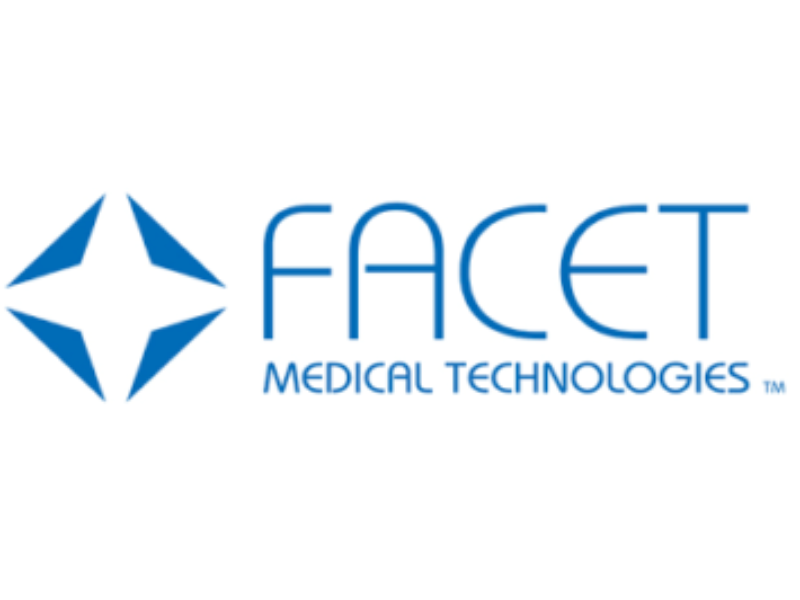Hoshin Kanri: Hidden Superpower for Organizational Excellence!
- Why Lean Management Matters
- 1. The Principle of Value
- 2. The Principle of Value Stream
- 3. The Principle of Flow
- 4. The Principle of Pull
- 5. The Principle of Perfection
- Lean Thinking: A Mindset for Success
- How to Implement Lean Principles in Your Organization?
- Conclusion: Transform Your Business with Lean Principles
- Key Takeaways
- FAQs
What Does Hoshin Kanri Mean?

Hoshin Kanri is a strategic planning and management system that originated in Japan and has been widely adopted by organizations around the world. It is also referred to as Strategy Deployment or Policy Deployment or simply Hoshin Planning.
It is a comprehensive approach to aligning an organization’s strategies and goals from top management down to the frontline employees.
The term “hoshin” literally translates to “compass needle” in Japanese, which symbolizes the need for a clear direction and focus for the organization. Kanri, on the other hand, means “management” or “control.”
Together, Hoshin Kanri represents a system that aims to ensure everyone in the organization is working towards the same objectives and is focused on continuous improvement
The PDCA Cycle is the backbone of the Hoshin Kanri process
Hoshin Kanri is a strategic planning methodology that aligns the organizational goals with the activities of different departments.

The PDCA, which stands for Plan-Do-Check-Act, is a cycle(also called the Deming cycle) of continuous improvement that acts as the engine that drives the improvement process within the Hoshin Kanri framework.
The Plan Stage
The first step of PDCA is the Plan, where the organization identifies its current state and defines the desired goals and objectives.
The Hoshin Kanri process starts with the creation of a long-term strategic plan, known as the “hoshin plan.”
This plan outlines the organization’s vision, mission, and major strategic objectives over a defined period, generally three to five years.
The company’s leadership shapes a compelling vision, addressing the fundamental question of “Why does the company exist?” This visionary perspective sets the stage for the organization’s journey.
The leadership team then formulates pivotal objectives, akin to a mission, which, when attained, confer a competitive advantage upon the company.
These objectives are substantial in scope, necessitating the collective efforts of every individual within the organization.
They transcend the realm of short-term, monthly, or quarterly objectives.
Subsequently, the leadership team collaborates with senior management to deconstruct these objectives into tangible annual goals.
These tangible goals are then deployed throughout the organization. It involves communicating the plan, breaking it down into smaller, actionable goals, and aligning individual performance targets with the overall strategy.
The Do stage
The next step is Do, where the organization implements the action plans developed in the previous stage.
This involves executing the planned improvements and making necessary changes.
The Check stage
Once the improvements have been implemented, the Check stage comes into play.
This step involves monitoring and measuring the results to determine if they meet the desired goals.
This phase helps in identifying any gaps or deviations.
Once the deployment is complete, progress towards the objectives is monitored through regular reviews, known as Hoshin Kanri “catchball” sessions, where feedback and lessons learned are shared and adjustments are made as necessary.
The Act stage
Finally, the Act stage(or some organizations refer to this as Adjust stage) is all about taking actions based on the results obtained in the Check stage.
This may involve standardizing the improvements, making adjustments, or adopting new approaches.
The Act/Adjust stage further strengthens the cycle by closing the loop and initiating the next round of improvement.
In summary, PDCA acts as a catalyst for continuous improvement within the Hoshin Kanri process, driving the organization towards achieving its long-term strategic objectives.
Why Hoshin Kanri matters?
Hoshin Kanri is not merely a strategic planning method; it’s a transformative philosophy that empowers organizations to bridge the gap between lofty strategic ambitions and on-the-ground execution.
The fundamental “why” behind Hoshin Kanri lies in its ability to foster a culture of alignment, continuous improvement, and relentless pursuit of organizational excellence.
By engaging employees at all levels in the planning and execution process, Hoshin Kanri taps into the collective wisdom of an organization, harnessing its full potential.
It offers a structured yet flexible approach that enables organizations to adapt swiftly to changing market conditions while ensuring that every action and resource is strategically aligned.
In essence, Hoshin Kanri empowers organizations to turn their visions into actionable plans, driving them toward sustained success and achieving their most ambitious goals.
When to use Hoshin Kanri ?
Hoshin Kanri, a strategic planning and execution methodology, is most effective when your organization faces the following scenarios:
- Need for Strategic Alignment: When there is a lack of alignment between day-to-day operations and long-term strategic objectives, Hoshin Kanri can bridge this gap.
- A desire for Continuous Improvement: Organizations seeking a culture of continuous improvement, where employees at all levels actively contribute to refining strategies and processes, can benefit from Hoshin Kanri.
- Complexity in Strategy Execution: In cases where strategic planning is complex and involves multiple departments or teams, Hoshin Kanri provides a structured approach to ensure everyone is working toward common goals.
- Changing Market Conditions: When market dynamics evolve rapidly, organizations require a flexible planning method like Hoshin Kanri to adapt quickly to new opportunities and challenges.
How to implement Hoshin Kanri? The 8-Step Hoshin Planning Process
Hoshin Kanri, a strategic planning and execution methodology, consists of seven essential steps that guide organizations toward their long-term vision.
Each step plays a crucial role in ensuring alignment between strategy and execution, fostering a culture of continuous improvement, and achieving organizational excellence. Let’s explore each step in detail:
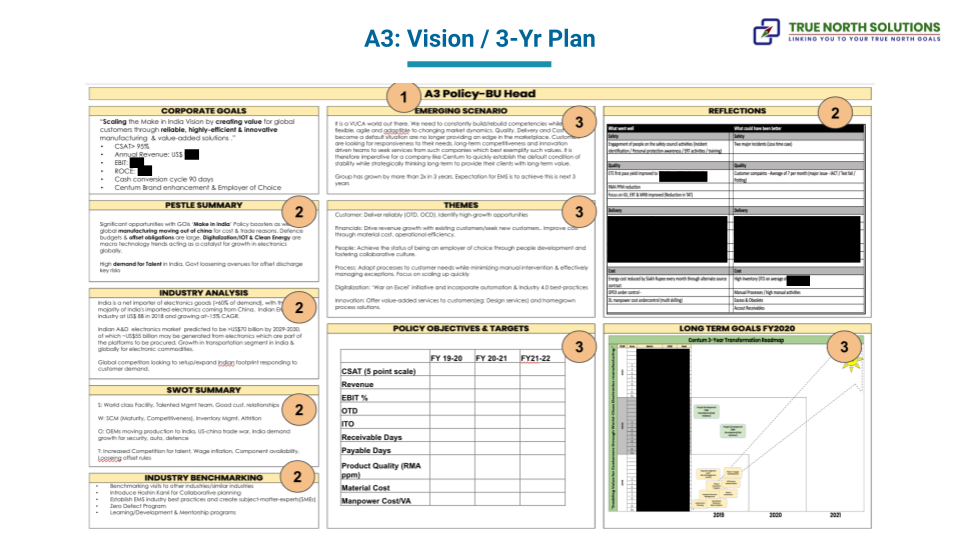
Step 1: Establish Your Organizational Vision
Explanation: Begin by defining your organization’s overarching vision. This is not just a statement; it’s a vivid portrayal of where you want your organization to be in the future. Your vision should be inspiring, aspirational, and capable of rallying employees at all levels.
Why It Matters: A clear and compelling vision serves as the North Star for your organization. It provides a shared sense of purpose, motivating employees and guiding decision-making at all levels.
Step 2: Develop Strategic Objectives
Explanation: Building upon your vision, create strategic objectives. These objectives are high-level, broad goals that directly support your vision. They articulate what your organization needs to achieve to realize its long-term aspirations.
Why It Matters: Strategic objectives provide focus and direction. They ensure that your organization’s efforts are channeled toward specific, meaningful goals that align with the bigger picture.
Step 3: Develop Annual Objectives
Explanation: Translate your strategic objectives into actionable annual objectives. Annual objectives are specific, measurable, achievable, relevant, and time-bound (SMART).
They serve as the bridge between your long-term strategy and your day-to-day operations.
Why It Matters: Annual objectives provide a clear roadmap for the current year. They break down the high-level strategy into manageable, executable components that guide teams and departments.
Step 4: Establish the Hoshin Kanri X Matrix for Strategy Deployment
The Hoshin Kanri matrix, often referred to as the X-Matrix, is a visual representation of the strategic planning process. It includes four main components:
- Strategic Objectives: These are the long-term goals that the organization aims to achieve. They represent the “what” of the strategy.
- Annual Objectives: Derived from the strategic objectives, these are specific, measurable goals for the current year. They define the “how” of the strategy.
- Action Plans: Action plans outline the initiatives and projects that teams or departments will undertake to achieve the annual objectives. They specify the “who” and “when.”
- Metrics and KPIs: Each objective and action plan is associated with specific metrics and key performance indicators. These measure progress and success.
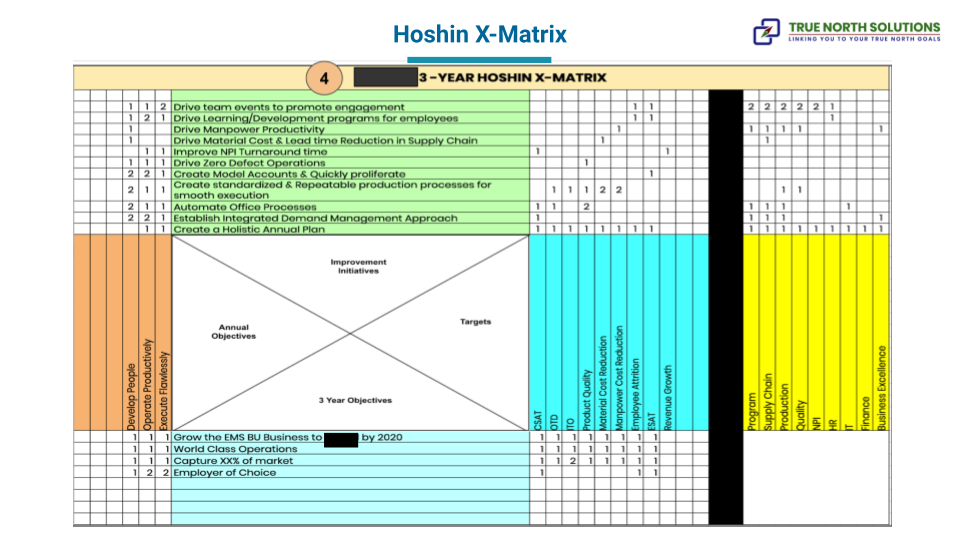
Reading a Hoshin Kanri matrix involves understanding the relationships between its components.
Strategic objectives are linked to annual objectives, which, in turn, connect to action plans. Metrics and KPIs provide a clear way to gauge progress and success.
The matrix helps visualize how each action plan supports the achievement of strategic objectives and how they align with the organization’s overall vision.
Step 5: Cascade Goals Throughout the Organization
Explanation: Ensure that every department, team, and individual within your organization understand their role in achieving the annual objectives. This involves cascading goals, a process that aligns every level with the organization’s strategic direction.
Why It Matters: Cascading goals promote alignment and accountability. It ensures that everyone is working in harmony towards the same objectives, fostering a cohesive and united workforce.
Step 6: Execute Annual Objectives
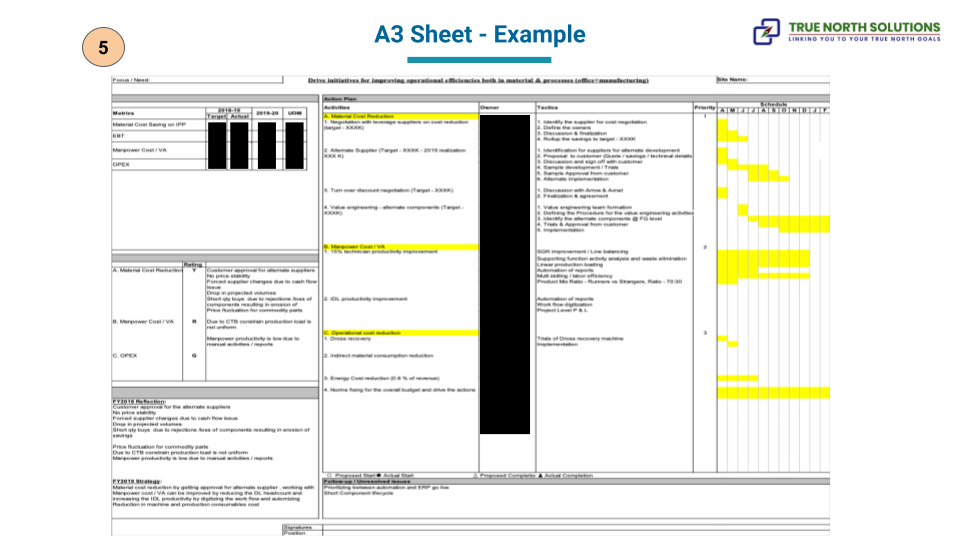
Explanation: With clear annual objectives in place, teams and departments develop action plans. These plans outline specific initiatives, projects, and tasks required to achieve the annual objectives. They specify responsibilities, timelines, and resource allocation.
Why It Matters: Execution is where strategy comes to life. Action plans provide the detailed steps needed to turn strategic intent into tangible results.
Step 7: Implement Monthly Reviews

Explanation: Regularly monitor progress towards the annual objectives through monthly reviews. These reviews involve analyzing performance metrics, key performance indicators (KPIs), and other relevant data. They offer an opportunity to identify early warning signs, challenges, and opportunities for improvement.
Why It Matters: Monthly reviews ensure that your organization stays on track. They provide a mechanism for quick course correction, preventing potential deviations from the strategic path.
Step 8: Conduct Annual Reviews
Explanation: At the end of the year, conduct comprehensive annual reviews. Evaluate the achievements against the annual objectives, celebrate successes, and critically assess any shortfalls. Use the insights gained to inform the next cycle of Hoshin Kanri planning.
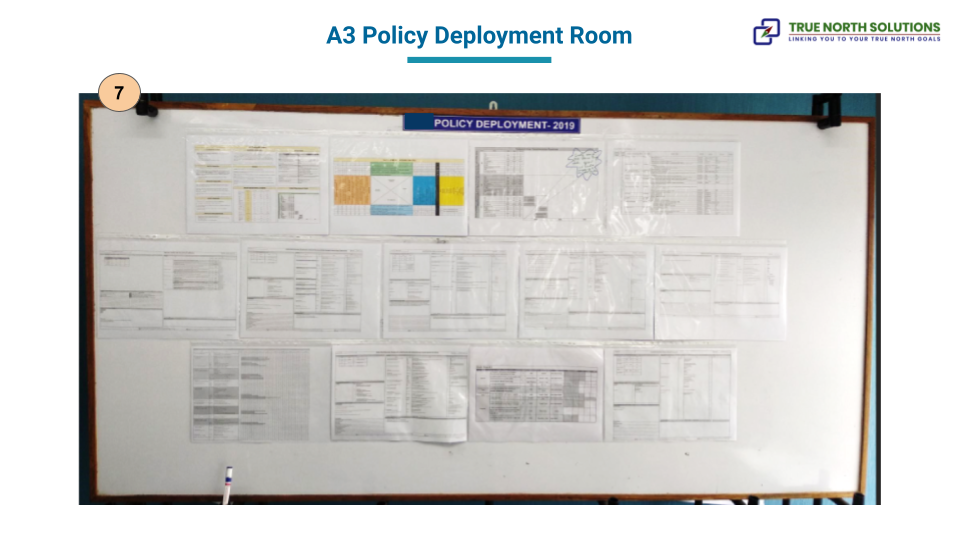
Why It Matters: Annual reviews close the loop in the Hoshin Kanri process. They facilitate learning, refinement, and continuous improvement, ensuring that each planning cycle builds upon the previous one.
By comprehensively understanding and implementing these seven steps, organizations can fully harness the power of Hoshin Kanri. This structured approach not only aligns strategy with execution but also nurtures a culture of continuous improvement, propelling organizations toward their long-term vision and beyond.
Pros and Cons of the Hoshin Kanri approach to Strategic Planning
Pros of the Hoshin Kanri methodology
- Strategic Alignment: Hoshin Kanri ensures alignment between strategy and execution at all organizational levels.
- Continuous Improvement: It fosters a culture of continuous improvement by involving employees in the planning and problem-solving process.
- Adaptability: The methodology is adaptable, allowing organizations to respond swiftly to changes in the external environment.
- Efficient Resource Allocation: Hoshin Kanri optimizes resource allocation, ensuring that resources are directed towards strategic priorities.
Cons of the Hoshin Kanri methodology
- Complexity: The method can be complex to implement, requiring training and commitment from all levels of the organization.
- Resource-Intensive: Proper execution demands time and resources, which may strain smaller organizations.
- Resistance to Change: Employees may resist the cultural shift required for Hoshin Kanri’s success.
By understanding when to use Hoshin Kanri, how to read the X-matrix, and the steps involved, organizations can leverage this powerful methodology to align strategy with execution, foster innovation, and drive success.
The pros and cons provide insights into what to expect, while active engagement and a commitment to continuous improvement bring the Hoshin Kanri matrix to life, transforming vision into reality.
True North Solutions: Revolutionizing Hoshin Kanri for Speed and Enhanced Benefits
While Hoshin Kanri, also known as Policy Deployment or Hoshin Planning, is a powerful methodology for strategic management, organizations often seek ways to tailor it to their unique needs for faster results and enhanced benefits.
True North Solutions, a trailblazer in the field of strategic management, has redefined how Hoshin Kanri is approached to drive efficiency, innovation, and success.
In this section, we’ll delve into how True North Solutions does Hoshin Kanri differently, yielding improved benefits and speed.
A Fresh Approach to Hoshin Kanri
We at True North Solutions approach Hoshin Kanri with a focus on adaptability and agility. Here’s how we differentiate ourselves:
1. Agile Hoshin Planning
Rather than rigid annual planning cycles, we embrace agile principles in Hoshin Kanri.
We break down long-term strategic objectives into shorter, iterative cycles, allowing for frequent adjustments and real-time responses to changing market dynamics.
This agile approach enables organizations to stay nimble and seize emerging opportunities swiftly.
Benefits:
- Faster response to market changes.
- Enhanced adaptability and flexibility.
- Rapid experimentation and innovation.
2. Digital Tools and Technology
We at True North Solutions leverage digital tools and technology to streamline the Hoshin Kanri process.
By using software platforms that facilitate collaborative planning, real-time monitoring, and data-driven decision-making, we expedite the deployment of strategies and the assessment of progress.
This digital transformation accelerates the entire Hoshin Kanri journey.
Benefits:
- Speedy communication and data sharing.
- Improved visibility into performance metrics.
- Enhanced decision-making through data analytics.
3. Data-Driven Decision-Making
Incorporating Lean Six Sigma principles, we emphasize data-driven decision-making in Hoshin Kanri.

We encourage organizations to collect and analyze relevant data to identify bottlenecks, measure the impact of initiatives, and make informed adjustments swiftly. This data-centric approach minimizes guesswork and optimizes the allocation of resources.
Benefits:
- Quick identification of areas for improvement.
- Evidence-based adjustments for better results.
- Efficient resource allocation based on performance metrics.
4. Cross-Functional Collaboration
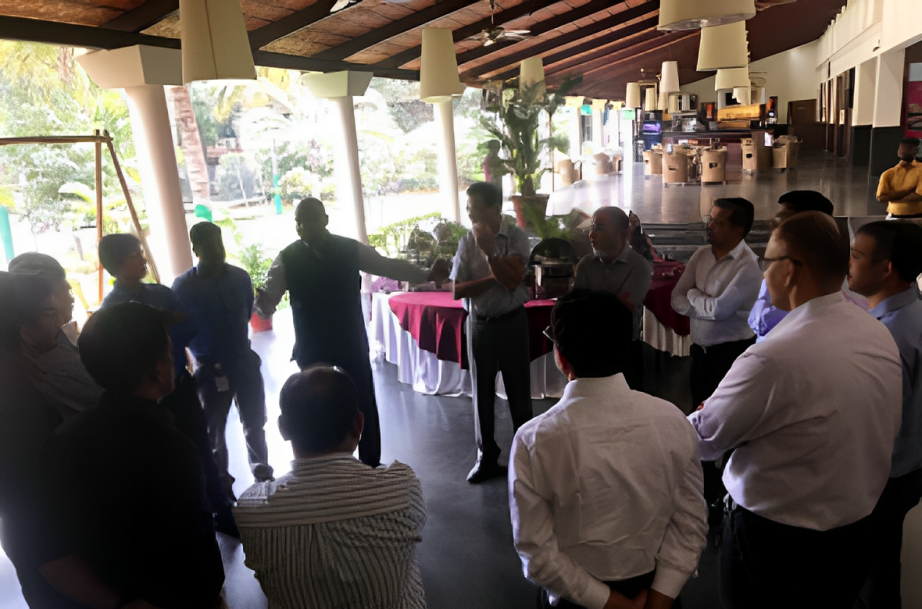
We believe that strategy deployment should not be confined to top-down communication but should involve all levels and departments.
This collaborative approach ensures that insights from different parts of the organization are considered, resulting in more robust and innovative strategies.
Benefits:
- Diverse perspectives drive innovation.
- Enhanced buy-in and commitment from all stakeholders.
- Faster identification and resolution of issues.
The True North Solutions Difference
True North Solutions has demonstrated that Hoshin Kanri can be more than a strategic planning method—it can be a catalyst for organizational transformation.
By infusing agility, digital technology, data-driven decision-making, and cross-functional collaboration into Hoshin Kanri, we enable organizations to achieve their strategic objectives with unprecedented speed and effectiveness.
True North Solutions has redefined Hoshin Kanri for the modern business landscape, where speed, adaptability, and innovation are essential for success.
Organizations that follow our lead can expect to experience the benefits of Hoshin Kanri at an accelerated pace, driving sustainable growth and excellence.
FAQs
What is Hoshin Kanri/Strategy Deployment?
Hoshin Kanri, also known as Strategy Deployment, is a management method that helps organizations align their strategic goals, breakthrough objectives, and key performance indicators.
It is a systematic approach to strategic planning and execution, which focuses on achieving long-term objectives while promoting continuous improvement.
What is catchball in Hoshin Kanri?
Catchball is a collaborative process in Hoshin Kanri where objectives and action plans are communicated between different levels of an organization.
It involves a two-way dialogue between senior management and middle managers to ensure that the objectives are aligned and feasible. Catchball helps in fine-tuning the plans and gaining consensus throughout the organization.
What are the benefits of using Hoshin Kanri?
Some benefits of using Hoshin Kanri include:
- Alignment of strategic goals throughout the organization
- Better communication and collaboration between different levels of management
- Clear focus on breakthrough objectives
- Promotion of continuous improvement and kaizen
- Improved decision-making based on data and analysis
- Increased employee engagement and ownership
- Monitoring and tracking of progress towards goals
How can Hoshin Kanri be used with Lean Six Sigma?
Hoshin Kanri can be used in conjunction with Lean Six Sigma to achieve strategic goals and drive process improvement.
By integrating the principles of Lean and Six Sigma with Hoshin Kanri, organizations can align their improvement efforts with their long-term objectives and ensure sustainable results.
What is the Hoshin Kanri X-Matrix?
The Hoshin Kanri X-Matrix is a planning tool used in Hoshin Kanri. It provides a visual representation of the strategic goals, breakthrough objectives, action plans, responsible individuals, and key performance indicators.
The X-Matrix helps in cascading the objectives throughout the organization and monitoring the progress of each initiative.
How does Hoshin Kanri bridge the gap between strategy and execution?
Hoshin Kanri bridges the gap between strategy and execution by aligning the strategic goals with the action plans and initiatives.
It ensures that the daily activities and improvement efforts are directed towards achieving the long-term objectives of the organization.
Hoshin Kanri provides a structured framework to translate strategy into actionable tasks and monitor the progress towards achieving the strategic goals.
What is the role of middle management in Hoshin Kanri?
Middle management plays a crucial role in Hoshin Kanri as they are responsible for the execution of the action plans and the cascading of objectives to the operational level.
They actively participate in catchball sessions, communicate the goals and plans to their teams, and monitor the progress towards achieving the objectives.
Middle management acts as a bridge between senior leadership and the frontline employees, ensuring the alignment of goals and the successful implementation of Hoshin Kanri.
How does Hoshin Kanri promote continuous improvement?
Hoshin Kanri promotes continuous improvement by integrating the principles of kaizen and Lean into the planning and execution process.
It encourages the identification of improvement opportunities, the use of Lean tools and techniques, and the regular review and adjustment of the action plans.
Hoshin Kanri creates a culture of continuous learning and improvement, facilitating the achievement of breakthrough objectives and the long-term success of the organization.
What makes Hoshin Kanri different from traditional strategic planning?
Hoshin Kanri differs from traditional strategic planning by its emphasis on the active involvement of all employees, the use of catchball and collaboration, and the focus on continuous improvement.
It provides a systematic approach to strategy execution, with clear action plans, monitoring mechanisms, and frequent review cycles.
Hoshin Kanri ensures that the strategy is not just a document but a living process that drives the organization towards its vision and goals.



